

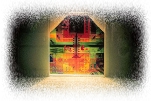
ART HOLOGRAPHY WITHOUT LASER
I. ACCESS ONLY
With a lab at home the relation between artist and laser will
be so to say intimate; being dependent of other labs limits the
time, intensity and sort of experiments and finally the quantity
of the works; the technical equipment definitely influences the
art. As a consequence, the inventions of an artist with laser
at home differ from those of an artist like me, who is traveling
to labs, in concept, technology and realisation. As a lot has
been written about the philosophical implications of art holography
I want to emphasize the genesis and the circumstances of my art
holography to characterize their aesthetics independent of the
year.
I take into account the change of site: it makes a 100% difference whether you give a talk in the "closed-circuit-installation" of art holographers in Nottingham or in the "mesh of an INTERnet".
II. HOW TO GET AWAY FROM YOUR MODEL
I worked many years with reflection holography before I went
over to holographic optical elements (HOE). I was lucky from
the beginning, because the first holograms were made with a pulsed
laser, ten minutes by bike away from my studio in Cologne. Therefore
I could use "impossible" materials for the models like
sheets of thin metal or even paper irrespective of any nanometer
movement. The small sculptures were painted black, white and
silver to change the final appearance. The holographic part of
"Pribram Looking for Engram" was meant as a symbol
for the brain, for thinking and imagining. The art piece refers
to the holographic brain theory en vogue at the eighties. (I
criticized Pribram's theory in my book "Holographic Art
- Perception, Evolution, Future", chapter II. "The
Hologram is an Empty, Lifeless Mirror" - www.holonet.khm.de)
I also integrated embossed holograms that you can buy. The patterns
in the emulsion that have been burned by strong light rays or
by reflecting metal coating accentuate the film and deliver free
another level in the space.
For other holographic models I mounted objets trouvés
as a collage and painted them fitting to the red laser light.
I always wanted a transformation of the models or even let disappear
their true constitution later in the hologram. Taken literally
the artifacts of 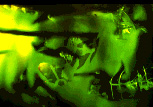 "Future
Perfect" are hidden; they are on focus far behind small
holes and unfocused far before the level of the holographic film.
Only transcending the holes one can see the real model in total.
I masked the
"Future
Perfect" are hidden; they are on focus far behind small
holes and unfocused far before the level of the holographic film.
Only transcending the holes one can see the real model in total.
I masked the
master with a collage of black abstract shapes during the first
exposure and, after turning around the film, with a correspondent
negative mask
during the second exposure on the same master. Two copies of
"Future Perfect" are exhibited as an orthoscopic and
pseudoscopic diptych. They are visually very complex and a challenge
for perception; I could not imagine the phenomenon before seeing
the copies. It's interesting, if an artist needs a week to understand
her own art work.......
III. ARTIFICIAL ARRANGEMENTS WITH INEVITABLE
HYBRIDISM
 "Pribram Looking
for Engram" clearly illustrates the nature of holography
as the inherent artistic problem, that means the discrepancy
between the two dimensional film as a medium and the three dimensional
holographic image. Having the catalogue of traditional disciplines
in your mind the question is:"Should I treat the hologram
as a painter or
"Pribram Looking
for Engram" clearly illustrates the nature of holography
as the inherent artistic problem, that means the discrepancy
between the two dimensional film as a medium and the three dimensional
holographic image. Having the catalogue of traditional disciplines
in your mind the question is:"Should I treat the hologram
as a painter or
as a sculptor?" Referring to the material aspect one could
frame the reflection hologram and hang it on the wall. I never
did it - except with one series including "Future Perfect"
in 1988. "Pribram" contains both artistic means, painting
and sculpture. The three pulse holograms on both sides are combined
with verre églomisé technique inside the sheets
of plexi glass sheltering the holograms. But even a painting
that goes perfect with the holographic image cannot resolve the
contrast between 2D and 3D. The transformator and the cables
for the neon that enlightens the head like an aura are exposed
in a case of plexi glass provoking the impression of an
artificial head or robot contrasting the concept of imagination.
To hide the electric stuff completely
inside the holographic sculptures was one option, but sometimes
I exposed it like here. This wonderful transformator with asphalt
surface was probably the last one available! Incorporating the
reflection hologram as a surface of geometric sculptures has
been another way of integration for several years; since 1991.
I left the reflection hologram transparent instead of backing
it with black plexi glass. This allows a fusion of real and holographic
objects. The installation "Gaia" is reconstructed pseudoscopically
on a field of briquets. The coal can be seen through the holographic
artifacts floating in the air;briquets and artifacts are melting
visually and symbolically.
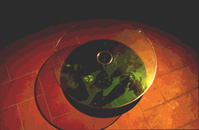
For the installation "Materia Trascendente" in the
cloister of San Salvatore in Florence I tried to go further in
a sculptural sense. One of the three black painted wooden cones
de facto comes through the hologram on top of it. The holographic
image appears in the space between film and cone and over the
ground floor. I think an artist really has to love ambivalence
to find an artistic solution for the holographic paradox!
IV. A HOLOGRAPHIC MAN CAN TURN YOUR
STOMACH
The most exciting transformation for me has always been the pseudoscopic
distortion. I studied the Denisyuk holograms in comparison to
their
models to understand possible transformations and to learn how
to build
the adequate model.
It started with a heavy irritation: When I called Prof. Dr. Gutjahr
and asked him about the pseudoscopic effect that I did not yet
know. He told me to turn around the pulse portrait of George;
with the ear piece between ear and shoulder I tilted the film
close to my eyes: George looked horrible! Again! Because the
lesson of my first holographic art piece  "Cartesian
Portrait of a Young Painter" had already been that the holographic
George is larger than obviously seen; the area of all "Georges"
stored simultaneously all over the emulsion is enormous.
"Cartesian
Portrait of a Young Painter" had already been that the holographic
George is larger than obviously seen; the area of all "Georges"
stored simultaneously all over the emulsion is enormous.
Therefore I say that the virtual head is monstrous". (see
"Holographic Art - Perception, Evolution, Future, chapter
I,1 "The Metaphysical
Monster" www. holonet.khm.de)
The phenomenon of distortion played an important role for several
holographic objects and led finally to a holographic discovery
and invention.
V. REINCARNATION OF AN OLD BABY
The increasing elongations and deviations became essential for
two art pieces referring to Leonardo's drawing of a baby which
is considered the oldest documented anamorphosis, dated approximately
about 1485. Originally I had been interested to see if an anamorphic
model also functions in three dimensions, but later I was wondering
about the relation between anamorphic and pseudoscopic phenomenons.
The holographic tests in the "Museum of Holography and New
Visual Media" in Pulheim near Cologne were so promising
that I made a relievo. The head of the baby is surrounded by
abstract real structures completed by a trompe l'oeil painting
for additive illusionary convex and concave holes. The edition
of holograms is framed in large plexi glass cases that I painted
inside like marble. "Leonardo's Baby" was created in
1985, that means 500 years after Leonardo's drawing. The art
piece looks beautiful, but doesn't really work as the intended
anamorphosis. After pestering with questions Andreas Neusser
who made the hologram I modeled two heads of the baby mirrored
and inclined with architectural elements around them. Finally
Daniel Weiss made the Denisyuk hologram of "Holographic
Anamorphosis for L.d.V." in La Coruna in Spain with a different
setting on the table.  Viewed
from the right side the right face turns into pure profile while
the left face stretches to two or three times its original size
and vice versa.
Viewed
from the right side the right face turns into pure profile while
the left face stretches to two or three times its original size
and vice versa.
Cutting the film into three pieces and turning around the architectural
parts above and below the faces one can see other distortions
appearing
there. This time the anamorphoses are really generated by holography.
(I analysed and described all the conditions of modeling and
holography in the article "Studies on Holographic Anamorphosis:
500 Years After", Leonardo, Vol.22, No.3/4, pp. 379-82.
http://mitpress.mit.edu/e-journals/leonardo/leoindex.html)
VI. I'M THE MASTER NOW!
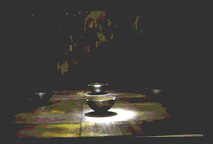 "Terrene Holosphere"
has been created for the 2nd Biennial in Nagoya '91. It was like
a summary of my former experiences, attempting a synthesis of
holography, sculpture and environmental painting.Transparent
reflection holograms are covering four steal hemispheres with
a diameter of 60 cm; the inside of these half "globes"
are black painted. I made one model in a hotel in Madrid with
plaster and other materials (including a cooked percebes), because
the pulse lab of Daniel Weiss was actually there. Rob Monday
in London managed the two copies on round glass which was difficult
to handle. I built a second model with technical artifacts in
Cologne and carried it to Prof. Boone in Gent for large Denisyuk
holograms.
"Terrene Holosphere"
has been created for the 2nd Biennial in Nagoya '91. It was like
a summary of my former experiences, attempting a synthesis of
holography, sculpture and environmental painting.Transparent
reflection holograms are covering four steal hemispheres with
a diameter of 60 cm; the inside of these half "globes"
are black painted. I made one model in a hotel in Madrid with
plaster and other materials (including a cooked percebes), because
the pulse lab of Daniel Weiss was actually there. Rob Monday
in London managed the two copies on round glass which was difficult
to handle. I built a second model with technical artifacts in
Cologne and carried it to Prof. Boone in Gent for large Denisyuk
holograms.
The two motifs for nature and technology are displayed both orthoscopic
and pseudoscopic; that means two times the holographic images
are inside
and two times outside the hemispheres which look empty as well
depending
on the viewing angle. Interesting is the orthoscopic version
of the copy "nature" that reveals the master as a bright
image in 30 cm distance under the film level.
Surrounding the hologram one can see the whole "garden"
behind the master window. Instead of being hidden in the lab
the master becomes officially an essential part of the art work.
VII. ETUDES IN TWO DIMENSIONS - NOT
COUNTING THE TIME
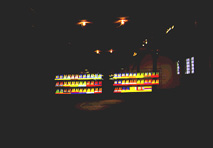 If I would not have
got a key board as a gift, I would not have created the music
holograms. After three years of piano lessons I was introduced
by the composer Hans w. Koch to the "Funktionsanalyse"
for a basic
If I would not have
got a key board as a gift, I would not have created the music
holograms. After three years of piano lessons I was introduced
by the composer Hans w. Koch to the "Funktionsanalyse"
for a basic
understanding of the harmony of Bach's Prelude in C Major of
the Well Tempered Clavier, Part I. I invented my own color language
to visualize the harmonic system and converted at first the music
piece of Bach into this color: tone system, later for comparison
the Preludes in C Major of Chopin, Busoni and Scriabin and an
early 12-tone study by Webern. At the same time, in 1993, the
institut ILB at the Fachhochschule Köln developed the professional
production of large and bright HOE films, composed of hundreds
or thousands of holographic optical elements in a size of e.g.
two by one centimeters. Prof. Dr. Gutjahr was open again to an
artistic application of the technology. I chose Bach's Prelude
in C Major, Webern's Study "Klavierstück" and
my "Extended Circle of Fifths"
for the chromatic notation in holography. The institute completed
and improved the exposure system and the computer soft ware,
because we needed more angles for the twelve tones (=colors)
and last not least a constancy of colors, independent of their
position. If the holograms are reconstructed one can see the
intended colors of the chromatic notation from a calculated viewing
point. My first studies of two dimensional holograms was based
on the holographic optical elements as "singles". (See
also: Leonardo Music Journal, Vol.5, 1995, pp. 5-10: "Chromatic
Notation of Music: Transforming Bach and Webern into Color and
Light"; http://www.mitpress.mit.edu/leonardo/home.html)
VIII: FIGURES WITH MASKS
HOEs are in fact very large pixels in rainbow colors. This does
not sound painterly to an artist, but they can be nice for abstract
compositions or symbolic ornaments. I made e.g. proposals with
symbolic ornaments for a 25 m long ceiling of an electricity
company building and for a glass wall in the National Theatre
of Kuala Lumpur. To get more detailed figuration I used again
masks; this time I painted with a special black felt pen on a
special transparent foil which was lying on the holographic film
during the exposure. 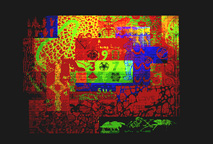 For
"An Orderly Chaos" I
For
"An Orderly Chaos" I
painted a positive mask for the first exposure and a negative
mask the
second exposure intending different colors. Contrasting pure
colors are
allow clearer shapes than mixed colors obtained by double exposure,
except magenta, and blank film which had been masked twice looks
black. "An Orderly Chaos" has been created for "Art
Special: Hansa 1996" taking place in the whole gymnasium
at Cologne (see http://www.dom.de/hansa)
Thinking of the life of teachers and their pupils I created a
wild collage of the constitutional elements of school: In a well
defined
composition of overlapping color fields there are a lot of objects
of natural sciences like the DNA spiral or the mechanics of a
jumping spider and a magic square with symbols instead of figures.
This order of science is undermined by graffiti (mainly) of the
girl's toilette which uncover "the underground of desires".
The realisation of these masks was a little bit difficult, because
I had to deal with constantly changing colors in this jungle
of crossing teaching objects and figures of fun. HOE holograms
are very bright and far reaching. The Prelude of Bach was shining
in 80 meters distance during the first exhibition. Unfortunately
I forgot to check next time, if it could be seen through the
glass wall of the KÖLN KUNST 1995 from the other side of
the river Rhine......
IX. ENVIRONMENTAL AWARENESS
But I could realize this idea in September 1998 in the cavity
of the Deutzer Bridge in the Heart of Cologne. In a synthesis
of the arts seven artists tried to feature all the architectonic
peculiarities of this unique space under the carriageway. 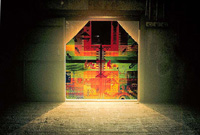 In the first room
of "Praise of the Shadow" a laser projection moving
forth and back let the people obviously slide away though they
were standing; on several places on the northern walls cars and
trams of the next bridge were darting headfirst like tiny toys,
because the whole bridge is functioning as a huge camera
In the first room
of "Praise of the Shadow" a laser projection moving
forth and back let the people obviously slide away though they
were standing; on several places on the northern walls cars and
trams of the next bridge were darting headfirst like tiny toys,
because the whole bridge is functioning as a huge camera
obscura....After more than 300 meters walk through the light
of images in the darkness of the bridge people entered the third
room realizing a glowing colorful gate at the end in 120 meters
distance: "CCAA" is a hologram about the first half
millennium of "Colonia Claudia Ara
Agrippinensium". The bright hologram covered the opening
of the exit
completely. Coming closer the meaning of the colour composition
reveals:
a cross of a blue blue and a red line symbolizes the river and
the bridge accentuating the actual situation of the people: having
crossed the Rhine they are "facing" the former Roman
fort whereas a formation of Barbarian shoes in Deutz just transcends
the river - depicted on the upper part of the hologram. Several
contrasting color fields in the lower part of the hologram refer
to historical sites like the Roman Forum and a temple or the
first Christian Church. The color concept is calculated for a
distance of about 25 meters, the figurative details of the image
can be seen coming closer with permanently changing colors: the
head of Agrippina who founded the city in 50 AD, the head of
Constantin who built the first bridge in Cologne in 315 AD and
many objects of daily life, work, religion and war reminding
the cultural development of the Roman, Christian and Barbarian
past of the city of Cologne.
X. FINAL REFLECTION ON TRANSMISSION
For many years my art in holography was four dimensional, if
we take in account the time of the "holographic dance"
in front of the reflection or transmission holograms. Working
with the transmission type of holographic optical elements one
has to define the third dimension as a distance between viewer
and hologram not as depth within the hologram itself. And the
spectral colors of light on your palette are all rectangular
like very big pixels. This technology brings me back to the drawing
table planning the color concept and painting the masks.
The photo engineers in the lab calculate the geometry and write
a program for the computer of the laser. When the film and the
mask are on the table of the holography lab and the laser starts,
they can go - "CCAA" has e.g. 5.412 exposures because
of the two masks.
These transmission holograms resemble stained glass windows illuminated
by the sun. Exposing them free in the space of an exhibition
room with the light on the wall behind it would be like taking
the windows of St. Peter in Cologne out of the wall and hanging
them in the nave of the cathedral. HOE are predestinated for
environmental art.